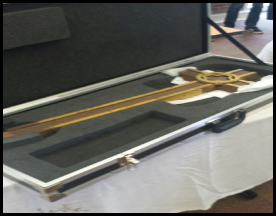
Symbols and rituals are not part of our usual Quaker faith and practice. Many have been the times, however, when I have found a symbol, an artifact, to be central to my continuing faith journey. Somewhere in me resides this window, or perhaps it is a door, with the smallest of cracks, and it is through that crack that what I know as "continuing affirmations" come to me. I do not necessarily need these affirmations to walk in faith, as I know we are often led to thoughts and actions that will not wait upon us to lay out a strategic plan, to have all the questions answered—no, there are times when it is incumbent upon us as people of faith to act in that faith.
It is comforting nonetheless when moments of affirmation come, as they come so often, when least expected. We must only have open and trusting hearts to accept them for the gifts they are to us. So many of these affirmations have blessed my life, from tiny moments with a grandchild, to coming together as a gathered meeting in worship, to being touched by an ad on television, or devastated by a photo of a child not yet two years old, drowned, with her arm around her young father’s neck. He, this "other" as some would call him, was doing what so many of us wonder if we would do if called upon: giving his own life to try to save his child.
In this time of deepening darkness I have been wondering if and when one of those "continuing affirmations" I might be open enough to seeing would appear. And there it was, laid out simply in the Quaker way, on a table in a room at Wilmington College as we came together to do the business of Yearly Meeting. It was a cross—not a large, ornate, bejeweled, covered-in-gold kind of cross—just this oh-so-sweet small wooden cross, looking as if it might have come from the hands of a craftsman, so warm and strong were the carved marks in its simple design.
On August 9, 1945, at 11:02 a.m., the United States dropped an atomic bomb above the city of Nagasaki, Japan. That bomb destroyed everything within an area of five square miles. At the center of the explosion was St. Mary’s Cathedral, also known as the Urikami Cathedral, where mass was being held that morning. The collapse of the cathedral destroyed everything, burying all those in worship. One item …. one item …. one artifact …. survived. It was that simple wooden cross that rested on that table at Wilmington College as we gathered in a prayer circle, with Japanese film documentary makers alongside us, filming us in prayer in our Quaker circle.
Who knows with certainty why or how (one of those continuing affirmations that we are called to accept in faith perhaps), but that cross had survived the years. In 1984 it was donated to the Peace Resource Center by Walter Hooke, a World War II veteran. With the support of Wilmington College, this one surviving artifact of that atomic bomb went back home to Japan in August, taken on its journey after 74 years by Campus Minister Nancy McCormick and Tanya Maus, Director of the Peace Resource Center.
Tanya and Nancy took the cross back to Nagasaki, where they presented it to the people attending the Urikami Cathedral, which was re-built in 1959. Members of the Nagasaki Peace Association had been looking for the cross since the bombing and now are grateful to Tanya, Nancy, Wilmington College, and Quakers for their care of the cross and for their act of reconciliation and love in making sure it was returned to its rightful place.
As part of that trip, Nancy also took 108 handmade rag dolls that represent hope and peace. The dolls were made over a one-year period by Quakers and other volunteers. They were presented to children in Japan in much the same way as Friendship Dolls were presented in 1927. “These symbols,” shares Nancy, “represent peace, hope, new life and power over evil. There’s something much bigger here than simply a cross and the dolls.” Something much bigger, no doubt!
